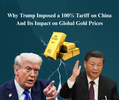
Why Trump Imposed a 100% Tariff on China — And Its Impact on Global Gold Prices
, by Someone You Know, 2 min reading time

, by Someone You Know, 2 min reading time
Trump’s latest 100% tariff on China has sent global markets into shock. As tensions rise over rare-earth exports, investors are turning to gold as a safe-haven asset — pushing prices upward worldwide.
The Background
In a surprising move, former U.S. President Donald Trump announced an additional 100% tariff on all Chinese imports, reigniting trade tensions between the world’s two largest economies. The decision came shortly after China introduced new export restrictions on rare earth elements and critical materials, which are vital for the production of electronics, defense equipment, and green technologies.
China currently dominates the global supply of these rare earths a group of 17 metals essential for high-tech manufacturing. The U.S. and several other nations depend heavily on these materials for industries like electric vehicles, semiconductors, and defense systems. Trump viewed China’s restrictions as an attempt to use its control over rare earths as political leverage, calling it a “hostile act” against U.S. interests.
In response, he imposed a 100% tariff on Chinese goods, stating that America would not tolerate trade manipulation or economic blackmail.
The Economic and Political Message
Beyond the rare earth issue, the move reflects a broader geopolitical strategy. Trump’s tariff serves multiple purposes:
Retaliation and Pressure — It’s a direct countermeasure to pressure Beijing into lifting export bans and returning to trade talks.
National Security — By discouraging reliance on Chinese imports, the U.S. hopes to strengthen its domestic manufacturing and safeguard strategic industries.
Political Posturing — With U.S. elections approaching, this move appeals to voters who favor strong trade protection and “America First” policies.
Negotiation Leverage — A higher tariff gives the U.S. bargaining power in future economic discussions with China.
Global Impact and Market Reactions
The announcement triggered immediate volatility in global financial markets. Stocks in both countries faced pressure, while investors flocked to safer assets like gold historically seen as a hedge during times of uncertainty.
As tensions escalated, gold prices briefly surged beyond the $4,000 per ounce mark before stabilizing. Analysts noted that the renewed U.S.–China trade friction has reinforced gold’s status as a “safe-haven” asset amid fears of global supply chain disruption and inflation.
Experts suggest that if the trade war deepens, gold could maintain an upward trend throughout the coming months, as central banks and investors seek security in tangible, value-preserving assets.
Why Gold Prices React to Trade Wars
Gold prices are closely tied to global sentiment. When geopolitical tensions rise:
Investors pull money from volatile equity markets and buy gold.
The U.S. dollar often weakens, which typically boosts gold prices since gold is priced in dollars.
Inflation expectations grow, leading investors to hedge with precious metals.
Thus, every escalation in trade conflict — especially between major economies tends to push gold prices upward.
Conclusion
Trump’s 100% tariff on China is more than a trade measure; it’s a strategic and symbolic move in a larger power struggle between Washington and Beijing. While it aims to defend U.S. industries and influence, it also introduces new waves of economic uncertainty that ripple across global markets.
For the gold industry, this policy shift is a clear signal: as trade tensions intensify, gold’s value as a safe-haven asset only grows stronger.